
Pantydia sparsa is a moth of the family Erebidae. It is found in Queensland and on Norfolk Island. This species was introduced to New Zealand in 2004.

Delgamma is a monotypic moth genus of the family Noctuidae erected by Frederic Moore in 1885. Its only species, Delgamma pangonia, the strawberry cutworm, was first described by Achille Guenée in 1852.

Pantydia is a genus of moths in the family Erebidae.
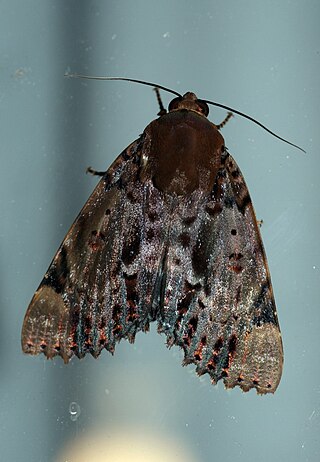
Arcte coerula, the ramie moth, is a moth of the family Noctuidae. The species was first described by Achille Guenée in 1852. It is found from in south-east Asia, including Fiji, India, Sri Lanka, Myanmar, Japan, New Guinea, Taiwan and Norfolk Island. It has been recently observed in Hawaii, on the island of Maui.

Ophisma gravata is a moth of the family Noctuidae first described by Achille Guenée in 1852. It is found from the Indo-Australian tropics of India, Sri Lanka, to Okinawa, Taiwan, the Caroline Islands, New Guinea, eastern Australia and New Caledonia.

Bastilla absentimacula is a moth of the family Noctuidae. It is found from the Indian subregion to Sri Lanka, Andaman Islands, Taiwan, Java and New Guinea.

Sympis rufibasis is a moth of the family Noctuidae first described by Achille Guenée in 1852. It is found from the Indo-Australian tropics of India, Sri Lanka, Borneo east to New Guinea, the Solomons and Queensland.
Notioplusia illustrata, the notioplusia moth, is a moth of the family Noctuidae first described by Achille Guenée in 1852. It is native to Saint Kitts, the Greater Antilles, Florida, Mexico, Panama and South America. It was introduced to Australia and South Africa.

Calyptra minuticornis, the vampire moth, is a moth of the family Erebidae. It has been found in Indonesia, Java, India, Sri Lanka, and Australasia.

Penicillaria jocosatrix, the mango shoot borer, is a moth of the family Euteliidae first described by Achille Guenée in 1852. It is found from southeast Asia to the Pacific. Records include Borneo, Guam, Hawaii, India, Sri Lanka, Thailand and in Australia, Western Australia, the Northern Territory and Queensland.

Eublemma cochylioides, the pink-barred eublemma, is a species of moth of the family Erebidae described by Achille Guenée in 1852.

Serrodes campana is a species of moth of the family Erebidae first described by Achille Guenée in 1852. It is found from the Indo-Australian tropics to eastern Australia, Fiji, Samoa and New Caledonia. It is also present in Japan, Korea and Sri Lanka. The adult is a fruit piercer, but also feeds on flower nectar.
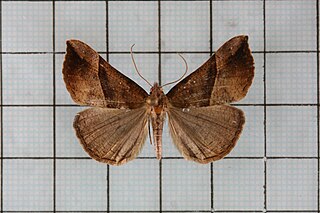
Hypospila bolinoides is a species of moth in the family Erebidae first described by Achille Guenée in 1852. The species is found from the Indo-Australian tropics of India, Sri Lanka, Myanmar, Andaman Islands, China north to Japan and east to New Guinea, Queensland and the Carolines.
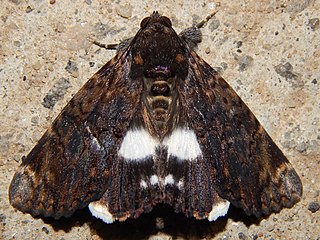
Nagia linteola is a species of moth in the family Erebidae first described by Achille Guenée in 1852. This species occurs in South Africa, the Democratic Republic of the Congo, Yemen, the Comoros, Mauritius, Madagascar, Indonesia (Borneo), India, Sri Lanka, Myanmar, Thailand and in Australia, where it has been recorded from Western Australia, the Northern Territory, Queensland and Victoria.

Erygia apicalis is a moth of the family Erebidae first described by Achille Guenée in 1852. It is found from the Indo-Australian tropics of India, Sri Lanka to Japan, Australia and the Solomon Islands. The habitat consists of lowland areas, including dry heath forests and softwood plantations.

Erygia spissa is a moth of the family Erebidae first described by Achille Guenée in 1852. It is found from the Indian subcontinent to New Guinea, where it is found in lowland habitats, including heath forests and coastal forests.
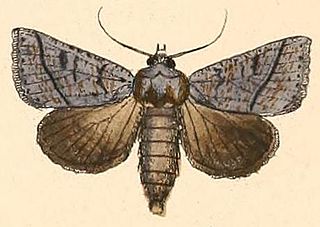
Pantydia canescens is a species of moth of the family Erebidae. It is found in Australia, where it has been recorded from Victoria.
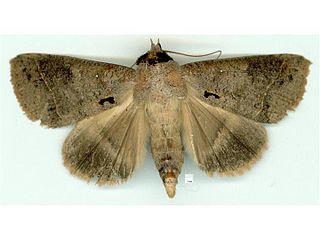
Pantydia metaspila is a species of moth of the family Erebidae first described by Francis Walker in 1858. It is found in China, Japan (Ryukyus), India (Maharashtra), Thailand, Taiwan, the Maledives, Sri Lanka, the Philippines, Borneo, Sumatra, Sulawesi, the Tanimbar Islands, Seram, Papua New Guinea, the Caroline Islands, the Solomon Islands, Vanuatu, Fiji, as well as Australia, where it has been recorded from Queensland.
Hypopyra unistrigata is a moth of the family Erebidae first described by Achille Guenée in 1852. It is found in China, India, Bangladesh, Sri Lanka (Trincomalee) and Cambodia.
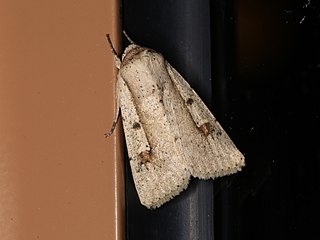
Leucania yu is a moth of the family Noctuidae first described by Achille Guenée in 1852. It is found in Oriental tropics of India, Sri Lanka, the Andaman Islands, Hong Kong, Indonesia, the Philippines, Taiwan east to Australia, Fiji and Tonga.
















